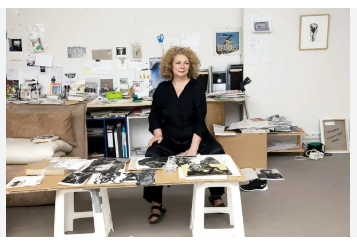
Marlene Dumas is a South African-born contemporary painter. She is known for figurative paintings and portraits that explore identity, sexuality, race, and emotion. Her work is raw, expressive, and internationally acclaimed. Dumas uses painting to confront human psychology, social issues, and personal experience.
Early Life
Marlene Dumas was born in 1953 in Cape Town, South Africa. She grew up during apartheid, which influenced her worldview. Her family encouraged creativity and critical thinking. She studied at the University of Cape Town and later in Amsterdam. Her early exposure to social inequality shaped her artistic themes.
Artistic Beginnings
Dumas began painting in the 1970s. She moved to Amsterdam to study at the Ateliers ‘63. Her work quickly attracted attention for emotional intensity and psychological depth. She often paints figures and faces to explore the human condition.
Major Works
-
Portraits (1987–1997) – Series exploring identity and human expression.
-
The Image as Burden (1993) – Examines media, politics, and representation.
-
Boy with Belly (1995) – Iconic figurative painting; raw and expressive.
-
Children of the Sea (2002) – Explores innocence, vulnerability, and humanity.
-
The Painter (2005) – Self-reflective works on art and identity.
-
Untitled (2019) – Large-scale works addressing contemporary social issues.
Portraits (1987–1997)
A long-term series focusing on human faces and expressions. The works capture emotion, vulnerability, and psychological states. Dumas examines both personal and social identity through portraiture.
The Image as Burden (1993)
A critical exploration of media and imagery. She questions how images shape perception of race, gender, and politics. It reflects Dumas’ interest in social consciousness and critique.
Children of the Sea (2002)
The painting explores innocence, vulnerability, and human emotion. It demonstrates her ability to convey psychological depth with minimal detail.
What Makes Her Different
-
Focuses on figurative painting with psychological intensity.
-
Explores race, sexuality, emotion, and identity.
-
Uses expressive brushwork and minimal color to convey mood.
-
Internationally recognized; works displayed in major museums.
-
Combines personal and political themes in her art.
Dumas’ paintings are both intimate and socially engaged.
Who Experiences Her Work
-
Art collectors and enthusiasts worldwide.
-
Students and scholars of contemporary art and figurative painting.
-
Audiences interested in human psychology, identity, and social critique.
-
Museum-goers seeking emotionally powerful visual art.
Her work appeals to both academic and general audiences.
Collaborations and Influence
-
Collaborated with galleries and museums worldwide.
-
Influenced contemporary painters exploring figurative and psychological art.
-
Mentored young artists and contributed to international art discourse.
Dumas bridges personal expression and social commentary.
Activism and Cultural Role
Her art addresses race, identity, and human vulnerability. She critiques societal norms, media, and representation. Through art, she encourages reflection on ethics, empathy, and humanity. Dumas is a cultural ambassador for contemporary South African art globally.
Later Years and Legacy
Marlene Dumas continues to paint, exhibit, and influence global art. Her works are in major collections worldwide, including MoMA, Tate, and Centre Pompidou. She is considered one of the most important contemporary painters from South Africa.
Legacy highlights:
-
Pioneer of figurative and psychological painting.
-
Influencer in contemporary global art and portraiture.
-
Chronicler of human emotion, identity, and social issues.
-
Role model for international South African artists.
Words
Marlene Dumas is more than a painter. She is a storyteller of emotion, identity, and human experience. Her art captures vulnerability, social issues, and psychological depth. It combines personal insight and global consciousness.
For anyone exploring contemporary painting, figurative art, or South African artists, Marlene Dumas is essential viewing and study.
Leave a Reply